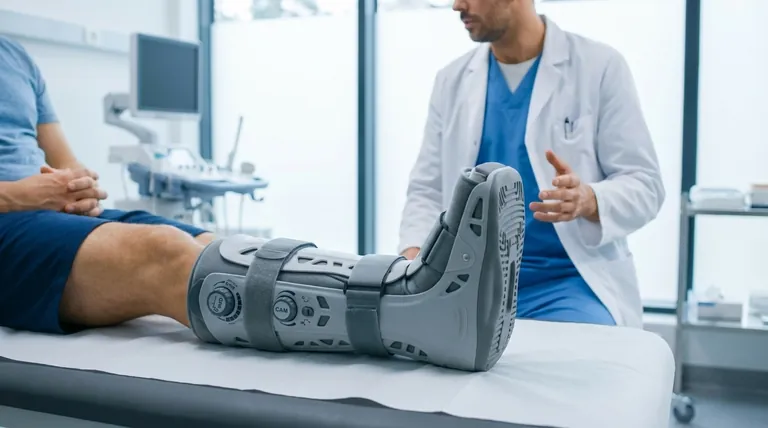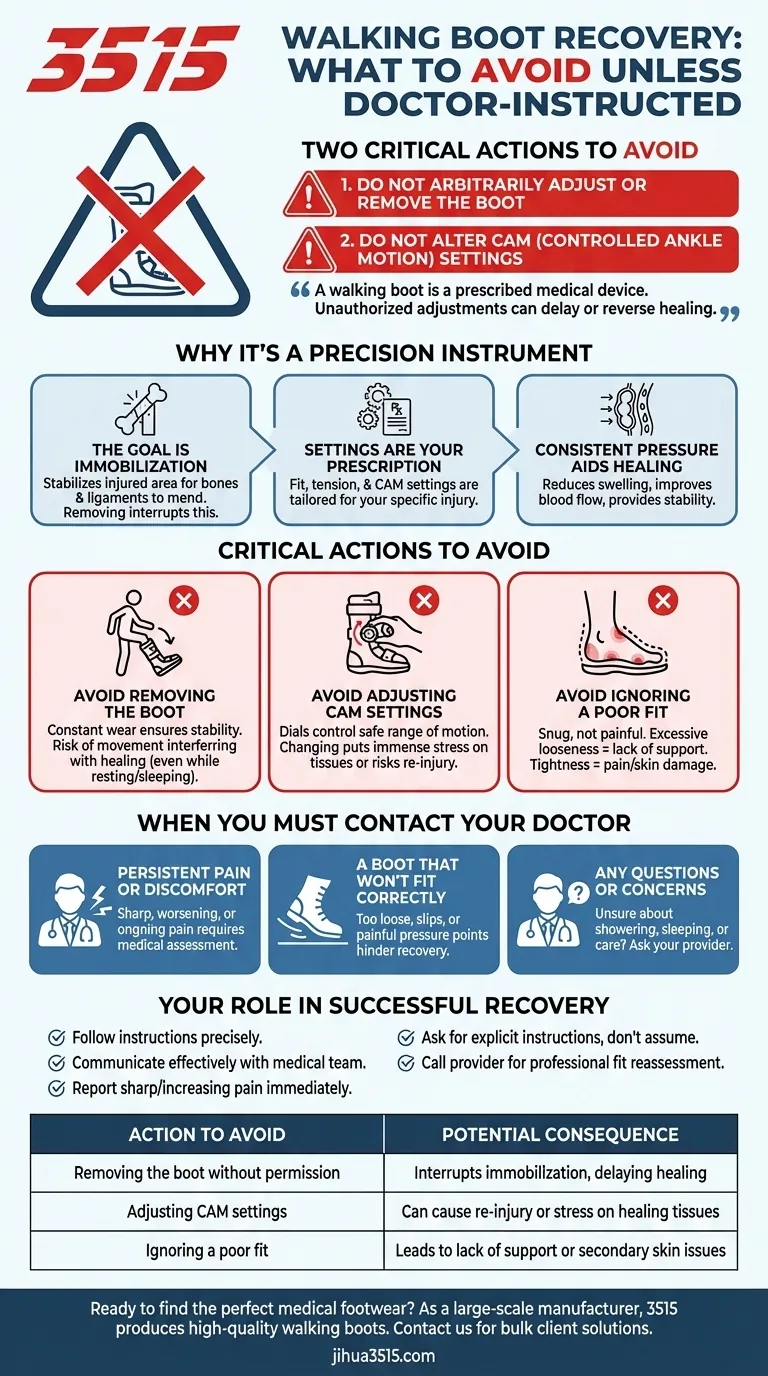Unless specifically instructed by your doctor, there are two critical actions you must avoid with a walking boot. Do not arbitrarily adjust or remove the boot, and if your boot has CAM (Controlled Ankle Motion) settings, do not alter them under any circumstances. These settings are prescribed for your specific injury and are essential for proper healing.
A walking boot is a prescribed medical device, not simply a supportive brace. Treating it like one and making your own adjustments can delay or even reverse your healing process. Your primary role is to maintain the settings provided by your healthcare professional.

Why a Walking Boot is a Precision Instrument
Understanding why these rules exist is key to a successful recovery. A walking boot is designed to create a very specific environment for your injury to heal, and unauthorized changes disrupt that environment.
The Goal is Immobilization
The fundamental purpose of the boot is to immobilize the injured area. For bones to mend or ligaments to repair, they must be held in a stable, protected position. Removing the boot without permission interrupts this critical process.
Settings are Your Prescription
Your doctor sets the boot's fit, strap tension, and any specific range-of-motion dials (CAM settings) based on the exact nature and severity of your injury. These settings are not arbitrary; they are a core part of your treatment plan.
Consistent Pressure Aids Healing
The air chambers or padding in a boot provide consistent, even pressure. This helps to reduce swelling, improve blood flow, and provide stability. An improperly fitted boot fails to deliver this therapeutic pressure.
Critical Actions to Avoid
To ensure you don't compromise your recovery, adhere strictly to the following guidelines unless your doctor gives you explicit, different instructions.
Avoid Removing the Boot
Constantly wearing the boot ensures the injury remains stable. Every time you remove it, you risk moving the injured area in a way that can interfere with the natural healing process. This includes while resting or sleeping.
Avoid Adjusting CAM Settings
If your boot has a dial or hinge, this is for Controlled Ankle Motion (CAM). Your doctor sets this to allow a specific, safe range of movement—or no movement at all. Changing this setting can put immense stress on the healing tissues or allow for re-injury.
Avoid Ignoring a Poor Fit
While you should not adjust the boot yourself, you must not ignore signs of a poor fit. The boot should be snug but not painfully tight. Excessive looseness means a lack of support, while tightness can cause pain, numbness, or skin damage.
When You Must Contact Your Doctor
Your responsibility is to monitor your situation and report problems. Do not try to solve them yourself.
Persistent Pain or Discomfort
Some initial discomfort is normal, but sharp, persistent, or worsening pain is a clear signal that something is wrong. Even if you can deflate an air chamber for temporary relief, ongoing pain requires medical assessment.
A Boot That Won't Fit Correctly
If the boot consistently feels too loose, slips, or creates painful pressure points, it is not functioning correctly. This is not something to "tough out," as it can hinder recovery and cause secondary issues like blisters or sores.
Any Questions or Concerns
There is no such thing as an insignificant question when it comes to your recovery. If you are unsure about any aspect of wearing or caring for your boot, your medical provider is your primary resource.
Your Role in a Successful Recovery
Your active participation is crucial, and that means following instructions and communicating effectively with your medical team.
- If you experience sharp or increasing pain: Contact your doctor immediately, as this may indicate a problem with the fit or your injury.
- If you are unsure about specific situations like sleeping or showering: Ask your doctor for explicit instructions rather than making an assumption.
- If the boot feels fundamentally wrong (too tight, loose, or chafing): Call your provider to have the fit professionally reassessed.
Following your doctor's instructions precisely is the most direct path to a full and efficient recovery.
Summary Table:
| Action to Avoid | Potential Consequence |
|---|---|
| Removing the boot without permission | Interrupts immobilization, delaying healing |
| Adjusting CAM settings | Can cause re-injury or stress on healing tissues |
| Ignoring a poor fit | Leads to lack of support or secondary skin issues |
Ready to find the perfect medical footwear for your needs? As a large-scale manufacturer, 3515 produces a comprehensive range of high-quality walking boots and orthopedic footwear for distributors, brand owners, and bulk clients. Our expertise ensures products that support proper healing and patient comfort. Contact us today to discuss your requirements and discover how we can support your business with reliable, effective solutions.
Visual Guide

Related Products
- Safety Footwear Wholesale Manufacturer for Custom OEM/ODM Production
- Premium Grain Leather Safety Boots for Bulk Supply
- Premium High-Cut Waterproof Safety Boots Manufacturing & Wholesale Solutions
- Premium Wholesale Wheat Nubuck Safety Boot with Rapid Lacing System
- Customizable Anti-Smash Safety Boots for Wholesale & Private Label Manufacturing
People Also Ask
- What are the cultural perspectives on wearing shoes in the house? A Guide to Home Etiquette & Hygiene
- How long can you wear safety boots? The Lifespan is Determined by Wear, Not Time
- What do heavy duty boots do? Protect Your Feet in Demanding Work Environments
- What are OSHA approved shoes? Understanding the Correct Standards for Workplace Safety
- What are the differences between steel toe, composite toe, and alloy toe Wellington boots? Choose the Right Safety Toe for Your Job



















